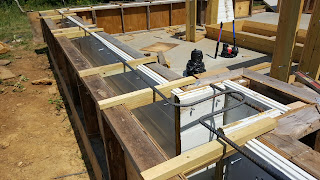As some of you may know, we have been working on the house for going on 3 years now. One of the many challenges we faced once we got all the timbers to Kansas was how to protect them from the weather while we worked on them. Naturally, last summer was one of the wettest we've seen which means having to move and re-level every beam every time Jeremy wanted to work on it. Progress was exceedingly slow and we clearly needed a better solution.
Luckily, we have an extra hoop house laying around! We put up about half of the 30'x96' hoop house over the slab and covered it with an old piece of plastic from our other hoop house. This gave a sheltered place for Jeremy to work where the beams could stay out as long as he needed them to. Progress accelerated dramatically!
Over the course of the fall, winter and into the early spring, Jeremy completed all the beams for the house, an addition and a barn! Go Jeremy! Here are a few of the pictures we took along the way.

Checking fit on the top post
Timber splice in the ridge pole.
Part of the second floor test fit before sanding
Sanding the floor joists
Tools of the trade! Wooden mallet and hearing protection.
One of the rafter beams assembled with collar tie
First floor post with summer beam
Jeremy admiring his handiwork in the hoop house
Once the joinery was done, we had to get ready to actually build the house, so the hoops had to come back down. That took a couple of days to do.
First, we pulled the plastic off and folded it up
Then we started taking apart the poles
Then everything gets loaded on the trailer
And then it gets unloaded in a new place
And here it will rest until we need it again!
Then we had to move all the beams off the slab so that we could start setting up concrete forms. Thank goodness for good friends! We managed to move them all in a day and get them stacked up by type near the building site. I can't wait until we're digging them back out to put in the house!
Started with piles on the slab
Then the piles moved here!
And every one was picked up by hand.
And moved, stacked, stickered and leveled.
The moving crew (minus me - I took the picture)!
Then we were ready to start building door and window bucks and setting up forms. I'll save that for a different post.
























